商务英语口译实训说课资料
- 格式:ppt
- 大小:1.54 MB
- 文档页数:27
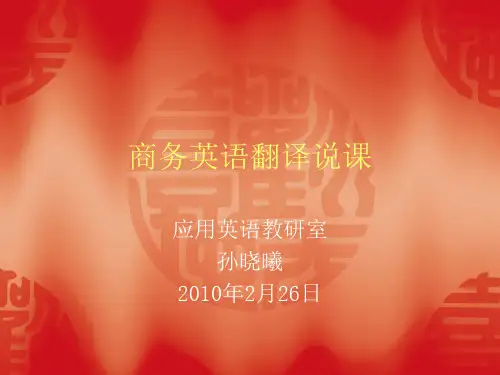
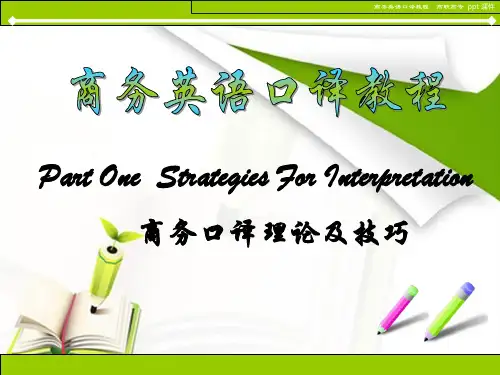
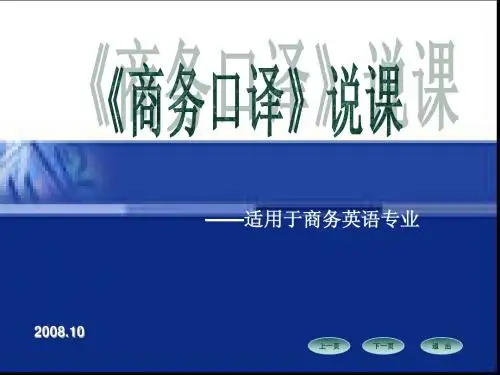
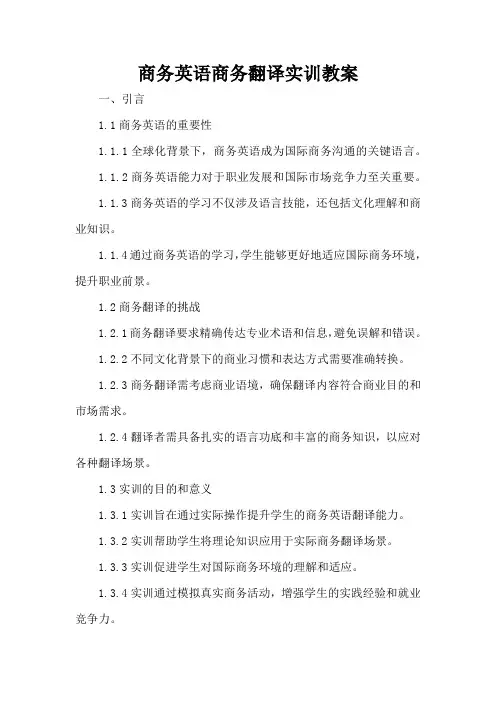
商务英语商务翻译实训教案一、引言1.1商务英语的重要性1.1.1全球化背景下,商务英语成为国际商务沟通的关键语言。
1.1.2商务英语能力对于职业发展和国际市场竞争力至关重要。
1.1.3商务英语的学习不仅涉及语言技能,还包括文化理解和商业知识。
1.1.4通过商务英语的学习,学生能够更好地适应国际商务环境,提升职业前景。
1.2商务翻译的挑战1.2.1商务翻译要求精确传达专业术语和信息,避免误解和错误。
1.2.2不同文化背景下的商业习惯和表达方式需要准确转换。
1.2.3商务翻译需考虑商业语境,确保翻译内容符合商业目的和市场需求。
1.2.4翻译者需具备扎实的语言功底和丰富的商务知识,以应对各种翻译场景。
1.3实训的目的和意义1.3.1实训旨在通过实际操作提升学生的商务英语翻译能力。
1.3.2实训帮助学生将理论知识应用于实际商务翻译场景。
1.3.3实训促进学生对国际商务环境的理解和适应。
1.3.4实训通过模拟真实商务活动,增强学生的实践经验和就业竞争力。
二、知识点讲解2.1商务英语基础2.1.1商务英语词汇:讲解常用商务词汇和短语,如“marketanalysis”、“negotiation”等。
2.1.2商务英语语法:介绍商务文本中常用的语法结构,如被动语态、复杂句型等。
2.1.3商务英语阅读:分析商务报告、邮件等文体的阅读技巧。
2.2商务翻译技巧2.2.1术语翻译:讲解如何准确翻译商务专业术语。
2.2.2文化适应:探讨如何处理文化差异,实现翻译的准确性。
2.2.3翻译质量控制:介绍翻译过程中如何确保质量,如校对、审稿等。
2.2.4翻译软件应用:讲解现代翻译辅助工具的使用,提高翻译效率。
2.3商务翻译实践2.3.1案例分析:通过分析真实商务翻译案例,提升学生的实际操作能力。
2.3.2模拟翻译:模拟实际商务翻译场景,让学生进行角色扮演和翻译练习。
2.3.3翻译反馈:提供翻译作品的反馈,指导学生改进翻译技巧。
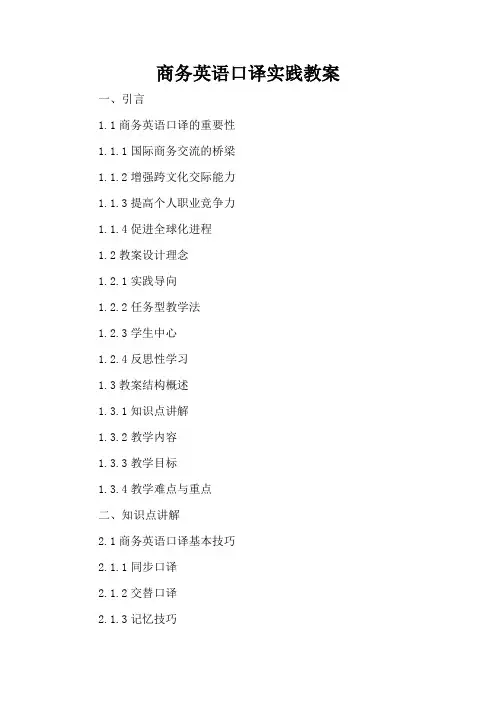
商务英语口译实践教案一、引言1.1商务英语口译的重要性1.1.1国际商务交流的桥梁1.1.2增强跨文化交际能力1.1.3提高个人职业竞争力1.1.4促进全球化进程1.2教案设计理念1.2.1实践导向1.2.2任务型教学法1.2.3学生中心1.2.4反思性学习1.3教案结构概述1.3.1知识点讲解1.3.2教学内容1.3.3教学目标1.3.4教学难点与重点二、知识点讲解2.1商务英语口译基本技巧2.1.1同步口译2.1.2交替口译2.1.3记忆技巧2.1.4翻译技巧2.2商务英语词汇与术语2.2.1常用商务词汇2.2.2行业术语2.2.3短语与表达2.2.4文化差异与翻译策略2.3跨文化交际能力2.3.1文化意识2.3.2非言语交际2.3.3跨文化适应2.3.4文化敏感性与口译三、教学内容3.1商务谈判口译3.1.1谈判策略与技巧3.1.2谈判语言特点3.1.3谈判场景模拟3.1.4谈判口译实践3.2商务会议口译3.2.1会议流程与规范3.2.2会议口译技巧3.2.3会议口译角色扮演3.2.4会议口译案例分析3.3商务陪同口译3.3.1陪同口译场景3.3.2陪同口译注意事项3.3.3陪同口译实践3.3.4陪同口译技能提升四、教学目标4.1知识目标4.1.1掌握商务英语口译基本技巧4.1.2熟悉商务英语词汇与术语4.1.3了解跨文化交际能力的重要性4.2技能目标4.2.1能够进行商务谈判口译4.2.2能够进行商务会议口译4.2.3能够进行商务陪同口译4.3情感目标4.3.1培养学生的团队合作意识4.3.2培养学生的自主学习能力4.3.3培养学生的跨文化交际意识五、教学难点与重点5.1教学难点5.1.1商务英语口译技巧的掌握5.1.2商务英语词汇与术语的记忆5.1.3跨文化交际能力的提升5.2教学重点5.2.1商务谈判口译实践5.2.2商务会议口译实践5.2.3商务陪同口译实践5.3教学策略5.3.1案例分析法5.3.2角色扮演法5.3.3小组合作学习法六、教具与学具准备6.1教具准备6.1.1投影仪与电脑6.1.2音响设备6.1.3口译设备(耳机、麦克风)6.1.4白板与白板笔6.1.5教学视频与音频材料6.2学具准备6.2.1笔记本电脑或平板电脑6.2.2口译练习资料6.2.3商务英语口译教材6.2.4口译录音设备6.2.5个人字典或电子词典6.3教学环境准备6.3.1安静且光线适宜的教室6.3.2分组讨论区域6.3.3网络连接6.3.4教学辅助软件七、教学过程7.1导入与热身7.1.1商务英语口译相关新闻分享7.1.2口译小游戏7.1.3学生自我介绍与口译练习7.1.4教学目标与内容概述7.2知识讲解与实践7.2.1商务英语口译技巧讲解7.2.2商务英语词汇与术语练习7.2.3跨文化交际案例分析7.2.4商务谈判口译模拟7.2.5商务会议口译模拟7.2.6商务陪同口译模拟7.3.1学生口译表现点评7.3.2学生反馈与问题解答7.3.4下节课预告与作业布置八、板书设计8.1教学重点与难点8.1.1商务英语口译技巧8.1.2商务英语词汇与术语8.1.3跨文化交际能力8.2教学流程8.2.1导入与热身8.2.2知识讲解与实践8.3教学辅助信息8.3.1商务英语口译相关网站推荐8.3.2口译练习资源8.3.3商务英语口译比赛信息九、作业设计9.1口译练习9.1.1商务谈判口译练习9.1.2商务会议口译练习9.1.3商务陪同口译练习9.2阅读与资料收集9.2.1阅读商务英语相关文章9.2.2收集商务英语口译案例9.2.3学习跨文化交际相关知识9.3.1口译练习中的困难与反思9.3.3下节课的准备与期待十、课后反思及拓展延伸10.1教学反思10.1.1教学目标的达成情况10.1.2教学方法的适用性10.1.3学生的参与度与反馈10.1.4教学内容的难易程度10.2拓展延伸10.2.1商务英语口译相关讲座或研讨会10.2.2参加商务英语口译比赛10.2.3商务英语口译实习机会10.2.4跨文化交际能力提升活动重点和难点解析在商务英语口译实践教案中,有几个环节是特别需要重点关注的,包括教学难点与重点的设定、教学过程的设计、作业设计,以及课后反思及拓展延伸。

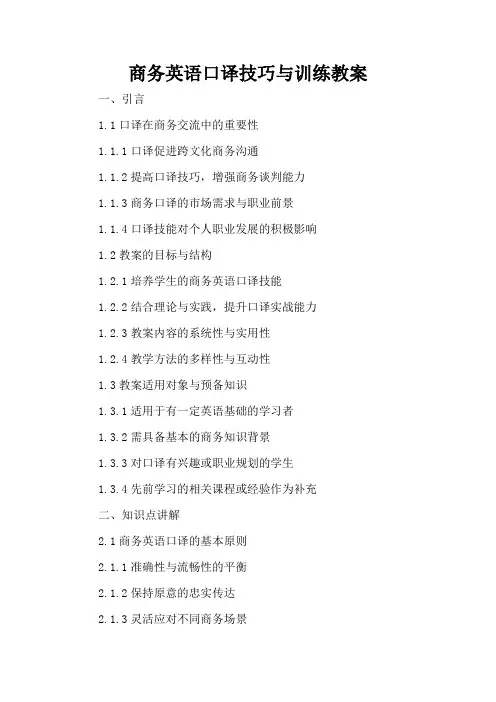
商务英语口译技巧与训练教案一、引言1.1口译在商务交流中的重要性1.1.1口译促进跨文化商务沟通1.1.2提高口译技巧,增强商务谈判能力1.1.3商务口译的市场需求与职业前景1.1.4口译技能对个人职业发展的积极影响1.2教案的目标与结构1.2.1培养学生的商务英语口译技能1.2.2结合理论与实践,提升口译实战能力1.2.3教案内容的系统性与实用性1.2.4教学方法的多样性与互动性1.3教案适用对象与预备知识1.3.1适用于有一定英语基础的学习者1.3.2需具备基本的商务知识背景1.3.3对口译有兴趣或职业规划的学生1.3.4先前学习的相关课程或经验作为补充二、知识点讲解2.1商务英语口译的基本原则2.1.1准确性与流畅性的平衡2.1.2保持原意的忠实传达2.1.3灵活应对不同商务场景2.1.4掌握专业术语与行业背景知识2.2口译技巧的专项训练2.2.1同步口译与交替口译的区别与应用2.2.2记忆技巧与笔记方法2.2.3短期记忆与长期记忆的结合2.2.4应对紧张与压力的策略2.3商务语境下的语言特点2.3.1商务英语的词汇特征2.3.2商务交流中的常用句型与表达2.3.3文化差异对商务口译的影响2.3.4口译中的跨文化沟通技巧三、教学内容3.1商务英语口译的实践场景3.1.1国际会议与商务谈判3.1.2电话与视频会议口译3.1.3商务考察与陪同口译3.1.4展览与促销活动的口译服务3.2教学方法与互动活动3.2.1角色扮演与模拟口译练习3.2.2小组讨论与案例分析3.2.3利用多媒体辅助教学3.2.4实战演练与反馈评估3.3教学评估与反馈机制3.3.1定期口译测试与成绩评定3.3.2学生自我评估与同伴评价3.3.3教师反馈与个别指导3.3.4教学内容的持续更新与优化四、教学目标4.1提升学生的商务英语口译能力4.1.1掌握商务口译的基本理论与技巧4.1.2能够准确、流畅地进行商务场景下的口译4.1.3增强学生的跨文化沟通与适应性4.1.4培养学生的快速反应与决策能力4.2强化学生的实战应用能力4.2.1通过模拟商务活动提升口译实战经验4.2.2增进学生对商务环境的了解与认识4.2.3提高学生在紧张环境下的口译表现4.2.4培养学生解决实际口译问题的能力4.3培养学生的自主学习与自我提升能力4.3.1鼓励学生自主探索口译资源与材料4.3.2培养学生定期自我练习与反思的习惯4.3.3提升学生利用反馈进行自我改进的能力4.3.4增强学生对口译职业发展的规划意识五、教学难点与重点5.1口译准确性及流利度的平衡5.1.1准确理解并转换专业术语与表达5.1.2在保持准确性的同时提升口译速度5.1.3应对口译过程中的信息丢失与误差5.1.4提高口译过程中的语言组织能力5.2跨文化沟通技巧的掌握5.2.1理解不同文化背景下的商务习俗5.2.2跨文化语境下的语言选择与适应5.2.3应对文化差异带来的口译挑战5.2.4提高在多元文化环境中的沟通效果5.3实战演练与心理素质的提升5.3.1克服实战演练中的紧张与焦虑5.3.2提高应对突发状况的应变能力5.3.3增强实战演练中的自信与专注力5.3.4通过实战演练提升口译综合能力六、教具与学具准备6.1教学辅助工具6.1.1多媒体设备(投影仪、音响等)6.1.2口译软件与在线资源6.1.3口译教学视频与音频材料6.1.4商务英语口译教材与参考书籍6.2学生活动材料6.2.1口译练习册与工作表6.2.2商务场景模拟道具与资料6.2.3同伴互评与自我评估表格6.2.4口译实战演练记录与反馈表6.3教学环境设置6.3.1安静、舒适的教学环境6.3.2配备口译设备的教室布局6.3.3用于小组讨论与角色扮演的空间七、教学过程7.1课程导入与热身活动7.1.1通过商务新闻或案例引入主题7.1.2进行简短的口译小游戏或练习7.1.3回顾上一节课的内容与重点7.1.4介绍本节课的目标与安排7.2知识讲解与技能训练7.2.1讲解商务口译的理论与技巧7.2.2进行同步与交替口译的练习7.2.3分析并讨论口译中的常见问题7.2.4引导学生掌握专业术语与表达7.3实战演练与反馈评估7.3.1进行商务场景模拟口译练习7.3.2学生分组进行角色扮演与互评7.3.3教师提供实时反馈与指导八、板书设计8.1课程主题与结构8.1.1板书商务英语口译技巧与训练8.1.2章节划分:引言、知识点讲解、教学内容等8.1.3关键术语与概念的高亮显示8.2教学重点与难点8.2.1板书展示口译技巧与原则8.2.2商务语境下的语言特点与应对策略8.2.3实战演练中的注意事项与技巧8.2.4教学难点与重点的图示化展示8.3实战演练与案例分析8.3.1板书记录模拟口译的场景与内容8.3.2展示实战演练中的口译问题与解决方法8.3.3案例分析的关键点与启示8.3.4学生口译表现的记录与评价九、作业设计9.1口译练习与自我评估9.1.1完成指定的商务口译练习9.1.2记录口译过程中的难点与挑战9.1.3进行自我评估与反馈9.1.4制定改进计划与目标9.2案例分析与研究报告9.2.1分析特定商务场景的口译案例9.2.3提出改进口译技巧的建议9.2.4分享案例分析与研究的心得9.3口译实战演练与反思9.3.1参与实战演练活动9.3.2记录演练过程与个人表现9.3.4探讨实战演练对提升口译能力的作用十、课后反思及拓展延伸10.1教学效果评估与反思10.1.1分析学生的口译表现与进步10.1.2反思教学方法的适用性与效果10.1.3调整教学策略与内容以提升效果10.1.4收集学生反馈以改进教学质量10.2拓展延伸活动10.2.1推荐相关口译资源与学习材料10.2.2鼓励学生参与口译工作坊与讲座10.2.3提供口译实战机会与平台10.2.4引导学生进行跨学科学习与研究重点环节补充说明:1.实战演练:这是提升学生口译能力的关键环节。
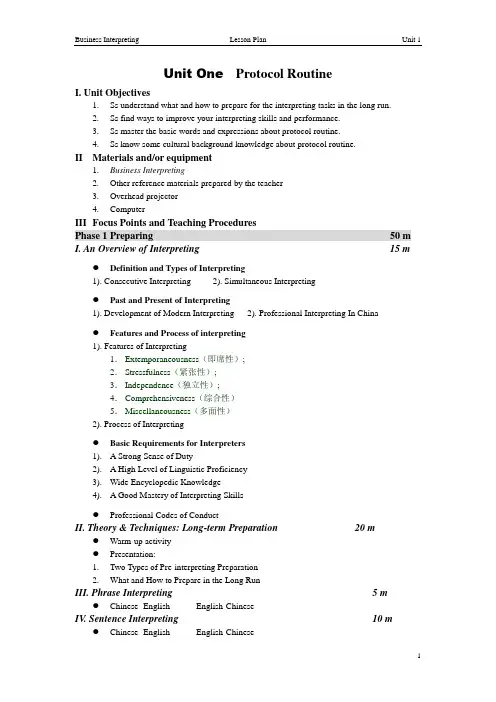
Unit One Protocol RoutineI. Unit Objectives1.Ss understand what and how to prepare for the interpreting tasks in the long run.2.Ss find ways to improve your interpreting skills and performance.3.Ss master the basic words and expressions about protocol routine.4.Ss know some cultural background knowledge about protocol routine.II Materials and/or equipment1.Business Interpreting2.Other reference materials prepared by the teacher3.Overhead projectorputerIII Focus Points and Teaching ProceduresPhase 1 Preparing 50 mI. An Overview of Interpreting 15 m●Definition and Types of Interpreting1). Consecutive Interpreting 2). Simultaneous Interpreting●Past and Present of Interpreting1). Development of Modern Interpreting 2). Professional Interpreting In China●Features and Process of interpreting1). Features of Interpreting1.Extemporaneousness(即席性);2.Stressfulness(紧张性);3.Independence(独立性);4.Comprehensiveness(综合性)5.Miscellaneousness(多面性)2). Process of Interpreting●Basic Requirements for Interpreters1). A Strong Sense of Duty2). A High Level of Linguistic Proficiency3). Wide Encyclopedic Knowledge4). A Good Mastery of Interpreting Skills●Professional Codes of ConductII. Theory & Techniques: Long-term Preparation 20 m●Warm-up activity●Presentation:1. Two Types of Pre-interpreting Preparation2. What and How to Prepare in the Long RunIII. Phrase Interpreting 5 m●Chinese- English English-ChineseIV. Sentence Interpreting 10 m●Chinese- English English-ChinesePhase 2 Performing 30 mI. Decoding--Notes Taking 5 mPlay the CD of text A, ask the students to catch the main ideas of the speech. Note down the key points while listening. Then tell the main ideas of the speech with the help of their notes.II. Memorizing--Story Retelling 5 mPlay the CD again, Ask some students to listen to the recordings of Text A again. Try to catch more details and improve their notes. Then retell the speech in their own words with the help of the notes.III. Encoding--Message Reconstructing 10 m●Play the CD again paragraph by paragraph, then ask the students to interpret the passageduring the pauses according to the notes they have taken. Choose some of the representatives to do it in class.●Show the reference note to the students, ask them to compare it with their own.●Then play the CD again which presenting the reference key. This time, the teacher will helpthem to check the interpretation.IV. Coordinating—Field Interpreting 10 m●Play the CD of text B. with a pause after each paragraph. Ask the students to take some noteswhile listening to the dialogue.●Ask two students to interpret what they have heard with the key points on their notes.●Choose some of the representatives to do it in class.●Then play the CD again which presenting the reference key. This time, the teacher will helpthem to check the interpretation.Phase 3 Packaging 20 mI. Interpreting and Assessment 15 m●Play the CD of text C with a pause after each paragraph. Ask the students to take some noteswhile listening to the speech..●Ask some students to interpret what they have heard with the key point on their notes.●Then ask two of them to do it again, one read the passage, the other tries to be the interpreter.Choose some of the representatives to do it in class.●Then play the CD again which presenting the reference key. This time, the teacher will helpthem to check the interpretation.●While the students are doing the interpretation of Text C, ask the other groups to makeassessment with their group members on the assessment form with the criterion given. In the end the teacher will ask the representatives to show the assessment form and then make some comment on the performance and assessment as well.II. Points to Remember 5 m● A well-prepared interpreter is usually confident and relaxed and an experiencedinterpreter never stops preparing for the interpreting tasks.●Interpreters must continually work to improve their mastery of basic linguistic andinterpreting skills; command of general and subject knowledge; and a strongcross-cultural awareness.●It is advisable for the trainees to keep on practicing interpreting, reading widely andlearning to collect and summarize what has been learned.After class activitiesI. Supplementary Exercises●Task I Simulation ExercisesDivide the students into several groups, ask them to role-play the following situations. They can make dialogues or speeches according to the words and expressions they have learned in the language bank acting as the Chinese speaker, English speaker and the interpreter respectively. One group will be invited to perform in class.●Task 2 Vocabulary DevelopmentAsk the students to read the following words and expressions about business travel. Try to keep them in mind so that they can put them to use in the simulation situations. Make some explanations where necessary. And ask them to find more to enrich the language bank.●Task 3Cultural SalonAsk the students to read the following presentation and try to get some cultural knowledge about travel arrangements. And make a group discussion about it. Make certain explanations where necessary.●Task 4 Interpreting PracticeAsk the students to work on the following sentences and text D. Interpret them into Chinese and English respectively. Then present the reference key to help them to check the answers.A. Sentence InterpretingB. Text Interpreting—Text DII. Self-assessment●After the students have completed all the tasks in this unit, ask them to finish the followingassessment form by themselves. This form contains some key points of interpretation skills, words and expressions, cultural background knowledge and the performance they have given.The teacher may give the reference answers to each element they have learned during this unit where necessary.III. Feedback and Comments●After they have finished the interpretation, ask the students to tell their classmates andteacher how they feel about the performance. Then you will make an overall comment on each of their performance and give your suggestion with the help of the following assessment form.Unit Two Ceremonial AddressI. Unit Objectives5.Ss understand what and how to prepare for the interpreting tasks in the short run.6.Ss find ways to improve your interpreting skills and performance.7.Ss master the basic words and expressions about ceremonial address.8.Ss know some cultural background knowledge about ceremonial address.II Materials and/or equipment5.Business Interpreting6.Other reference materials prepared by the teacher7.Overhead projectorputerIII Focus Points and Teaching ProceduresPhase 1 Preparing 50 m I. Simulation 15 m Divide the students into several groups, ask them to role-play the following situations. They can make dialogues or speeches according to the words and expressions they have learned in the language bank acting as the Chinese speaker, English speaker and the interpreter respectively. One group will be invited to perform in class.●While the students are doing the simulation interpretation, ask the other groups to makeassessment with their group members on the assessment form with the criterion given. In the end the teacher will ask the representatives to show the assessment form and then make some comment on the performance and assessment as well.II. Theory & Techniques: Short-term preparation 20 m●Warm-up activity●Presentation:1.What to Prepare?2.How to Prepare?A Sample Question ListTo Organizer:1.May I have the schedule? Will there be any changes about the schedule?2.Is it possible for me to have the speakers’ speech drafts or ppt slides?3.Who will attend the conference? Is there a Q & A session?4.Who are the key-note speakers? How can I get in touch with them?To Speaker:1.How long will the speech last?2.What are your main points? Are you going to add or cut any points?3.Are you going to use any technical terms?4.May I have your draft or ppt slides?III. Phrase Interpreting 5 m●Chinese- English English-ChineseIV. Sentence Interpreting 10 m●Chinese- English English-ChinesePhase 2 Performing 30 mI. Decoding--Notes Taking 5 mPlay the CD of text A, ask the students to catch the main ideas of the speech. Note down the key points while listening. Then tell the main ideas of the speech with the help of their notes.II. Memorizing--Story Retelling 5 mPlay the CD again, Ask some students to listen to the recordings of Text A again. Try to catch more details and improve their notes. Then retell the speech in their own words with the help of the notes.III. Encoding--Message Reconstructing 10 m●Play the CD again paragraph by paragraph, then ask the students to interpret the passageduring the pauses according to the notes they have taken. Choose some of the representatives to do it in class.●Show your note to the students, ask them to compare it with their own.●Then play the CD again which presenting the reference key. This time, the teacher will helpthem to check the interpretation.IV. Coordinating—Field Interpreting 10 m●Play the CD of text B. with a pause after each paragraph. Ask the students to take some noteswhile listening to the dialogue.●Ask two students to interpret what they have heard with the key points on their notes.●Choose some of the representatives to do it in class.●Then play the CD again which presenting the reference key. This time, the teacher will helpthem to check the interpretation.Phase 3 Packaging 20 mI. Interpreting and Assessment 15 m●Play the CD of text C with a pause after each paragraph. Ask the students to take some noteswhile listening to the speech..●Ask some students to interpret what they have heard with the key point on their notes.●Then ask two of them to do it again, one read the passage, the other tries to be the interpreter.Choose some of the representatives to do it in class.●Then play the CD again which presenting the reference key. This time, the teacher will helpthem to check the interpretation.●While the students are doing the interpretation of Text C, ask the other groups to makeassessment with their group members on the assessment form with the criterion given. In the end the teacher will ask the representatives to show the assessment form and then make some comment on the performance and assessment as well.II. Points to Remember 5 m●The short-term preparation refers to the job that can only be prepared shortly beforethe interpreting task is taken.●The interpreter shall beforehand prepare the relevant documents and terminology;dictionaries and note-books; proper dresses and name cards.●The following three ways are suggested when making short-term pre-interpreting preparation,namely, read through the relevant documents; surf the internet; contact the organizer and the speakers.After class activitiesI. Supplementary Exercises●Task I Simulation ExercisesDivide the students into several groups, ask them to role-play the following situations. They can make dialogues or speeches according to the words and expressions they have learned in the language bank acting as the Chinese speaker, English speaker and the interpreter respectively. One group will be invited to perform in class.●Task 2 Vocabulary DevelopmentAsk the students to read the following words and expressions about business travel. Try to keep them in mind so that they can put them to use in the simulation situations. Make some explanations where necessary. And ask them to find more to enrich the language bank.●Task 3Cultural SalonAsk the students to read the following presentation and try to get some cultural knowledge about travel arrangements. And make a group discussion about it. Make certain explanations where necessary.●Task 4 Interpreting PracticeAsk the students to work on the following sentences and text D. Interpret them into Chineseand English respectively. Then present the reference key to help them to check the answers.A. Sentence InterpretingB. Text Interpreting—Text DII. Self-assessment●After the students have completed all the tasks in this unit, ask them to finish the followingassessment form by themselves. This form contains some key points of interpretation skills, words and expressions, cultural background knowledge and the performance they have given.The teacher may give the reference answers to each element they have learned during this unit where necessary.III. Feedback and Comments●After they have finished the interpretation, ask the students to tell their classmates andteacher how they feel about the performance. Then you will make an overall comment on each of their performance and give your suggestion with the help of the following assessment form.Unit Three Dinner PartyI. Unit Objectives1.Ss understand the importance and guidelines of active listening.2.Ss find ways to improve your interpreting skills and performance.3.Ss master the basic words and expressions about dinner party.4.Ss know some cultural background knowledge about dinner party.II Materials and/or equipment9.Business Interpreting10.Other reference materials prepared by the teacher11.Overhead projectorputerIII Focus Points and Teaching ProceduresPhase 1 Preparing 50 mI. Simulation 15 m Divide the students into several groups, ask them to role-play the following situations. They can make dialogues or speeches according to the words and expressions they have learned in the language bank acting as the Chinese speaker, English speaker and the interpreter respectively. One group will be invited to perform in class.●While the students are doing the simulation interpretation, ask the other groups to makeassessment with their group members on the assessment form with the criterion given. In the end the teacher will ask the representatives to show the assessment form and then make some comment on the performance and assessment as well.II. Theory & Techniques: Active Listening 20 m●Warm-up activity●Presentation:1.Decoding in Interpreter’s Training2.Three Guidelines for Active Listening3. Three Methods to Listen ActivelyIII. Phrase Interpreting 5 m●Chinese- English English-ChineseIV. Sentence Interpreting 10 m●Chinese- English English-ChinesePhase 2 Performing 30 mI. Decoding--Notes Taking 5 mPlay the CD of text A, ask the students to catch the main ideas of the speech. Note down the key points while listening. Then tell the main ideas of the speech with the help of their notes.II. Memorizing--Story Retelling 5 mPlay the CD again, Ask some students to listen to the recordings of Text A again. Try to catch more details and improve their notes. Then retell the speech in their own words with the help of the notes.III. Encoding--Message Reconstructing 10 m●Play the CD again paragraph by paragraph, then ask the students to interpret the passageduring the pauses according to the notes they have taken. Choose some of the representatives to do it in class.●Show your note to the students, ask them to compare it with their own.●Then play the CD again which presenting the reference key. This time, the teacher will helpthem to check the interpretation.IV. Coordinating—Field Interpreting 10 m●Play the CD of text B. with a pause after each paragraph. Ask the students to take some noteswhile listening to the dialogue.●Ask two students to interpret what they have heard with the key points on their notes.●Choose some of the representatives to do it in class.●Then play the CD again which presenting the reference key. This time, the teacher will helpthem to check the interpretation.Phase 3 Packaging 20 mI. Interpreting and Assessment 15 m●Play the CD of text C with a pause after each paragraph. Ask the students to take some noteswhile listening to the speech..●Ask some students to interpret what they have heard with the key point on their notes.●Then ask two of them to do it again, one read the passage, the other tries to be the interpreter.Choose some of the representatives to do it in class.●Then play the CD again which presenting the reference key. This time, the teacher will helpthem to check the interpretation.●While the students are doing the interpretation of Text C, ask the other groups to makeassessment with their group members on the assessment form with the criterion given. In the end the teacher will ask the representatives to show the assessment form and then make some comment on the performance and assessment as well.II. Points to Remember 5 m●Decoding is the first step in interpreting.●Both CI and SI require not ordinary listening but active listening.●Interpreters listen to meaning instead of words, they listen for both content andattitude, and they listen with ears, eyes, heart.●To improve the efficiency of active listening, interpreters are supposed to sit or standcomfortably upright; observe the speaker’s body language; and try to visualize the words. After class activitiesI. Supplementary Exercises●Task I Simulation ExercisesDivide the students into several groups, ask them to role-play the following situations. They can make dialogues or speeches according to the words and expressions they have learned in the language bank acting as the Chinese speaker, English speaker and the interpreter respectively. One group will be invited to perform in class.●Task 2 Vocabulary DevelopmentAsk the students to read the following words and expressions about business travel. Try to keep them in mind so that they can put them to use in the simulation situations. Make some explanations where necessary. And ask them to find more to enrich the language bank.●Task 3Cultural SalonAsk the students to read the following presentation and try to get some cultural knowledge about travel arrangements. And make a group discussion about it. Make certain explanations where necessary.●Task 4 Interpreting PracticeAsk the students to work on the following sentences and text D. Interpret them into Chinese and English respectively. Then present the reference key to help them to check the answers.A. Sentence InterpretingB. Text Interpreting—Text DII. Self-assessment●After the students have completed all the tasks in this unit, ask them to finish the followingassessment form by themselves. This form contains some key points of interpretation skills, words and expressions, cultural background knowledge and the performance they have given.The teacher may give the reference answers to each element they have learned during this unit where necessary.III. Feedback and Comments●After they have finished the interpretation, ask the students to tell their classmates andteacher how they feel about the performance. Then you will make an overall comment on each of their performance and give your suggestion with the help of the following assessment form.Unit Four Business TravelI. Unit Objectives1. Ss understand the ways to identify the main ideas of the source text.2. Ss find ways to improve your interpreting skills and performance.3. Ss master the basic words and expressions about business travel.4. Ss know some cultural background knowledge about business travel.II Materials and/or equipment13.Business Interpreting14.Other reference materials prepared by the teacher15.Overhead projectorputerIII Focus Points and Teaching ProceduresPhase 1 Preparing 50mI. Simulation 15m●Divide the students into several groups, ask them to role-play the following situations. Theycan make dialogues or speeches according to the words and expressions they have learned in the language bank acting as the Chinese speaker, English speaker and the interpreter respectively. One group will be invited to perform in class. assessment with their group members on the assessment form with the criterion given. In the end the teacher will ask the representatives to show the assessment form and then make some comment on the performance and assessment as well.II. Theory & Techniques: Discourse Analysis 20m●Warm-up activity●Presentation:1.Identification of the Speech Types1). Descriptive Writing 2). Narrative Writing3). Expositive Writing 4). Persuasive Writing2. Identification of the Main Ideas1). Sentence Level 2). Discourse LevelIII. Phrase Interpreting 5 m●Chinese- English English-ChineseIV. Sentence Interpreting 10 m●Chinese- English English-ChinesePhase 2 Performing 30 mI. Decoding--Notes Taking 5 mPlay the CD of text A, ask the students to catch the main ideas of the speech. Note down the key points while listening. Then tell the main ideas of the speech with the help of their notes.II. Memorizing--Story Retelling 5 mPlay the CD again, Ask some students to listen to the recordings of Text A again. Try to catch more details and improve their notes. Then retell the speech in their own words with the help of the notes.III. Encoding--Message Reconstructing 10 m●Play the CD again paragraph by paragraph, then ask the students to interpret the passageduring the pauses according to the notes they have taken. Choose some of the representatives to do it in class.●Show your note to the students, ask them to compare it with their own.●Then play the CD again which presenting the reference key. This time, the teacher will helpthem to check the interpretation.IV. Coordinating—Field Interpreting 10 m●Play the CD of text B. with a pause after each paragraph. Ask the students to take some noteswhile listening to the dialogue.●Ask two students to interpret what they have heard with the key points on their notes.●Choose some of the representatives to do it in class.●Then play the CD again which presenting the reference key. This time, the teacher will helpthem to check the interpretation.Phase 3 Packaging 20 mI. Interpreting and Assessment 15 m●Play the CD of text C with a pause after each paragraph. Ask the students to take some noteswhile listening to the speech.●Ask some students to interpret what they have heard with the key point on their notes.●Then ask two of them to do it again, one read the passage, the other tries to be the interpreter.Choose some of the representatives to do it in class.●Then play the CD again which presenting the reference key. This time, the teacher will helpthem to check the interpretation.●While the students are doing the interpretation of Text C, ask the other groups to makeassessment with their group members on the assessment form with the criterion given. In the end the teacher will ask the representatives to show the assessment form and then make some comment on the performance and assessment as well.II. Points to Remember 5 m●An analysis of speech types is a determinant factor in interpreting.●There are four basic speech types: descriptive, persuasive, expository, and narrative.●The main ideas of the source speech can be identified at the sentence level and at thediscourse level.●The most important task for an interpreter is to discern from the clusters of utterances thesubject, verb and object.After class activitiesI. Supplementary Exercises●Task I Simulation ExercisesDivide the students into several groups, ask them to role-play the following situations. They can make dialogues or speeches according to the words and expressions they have learned in the language bank acting as the Chinese speaker, English speaker and the interpreter respectively. One group will be invited to perform in class.●Task 2 Vocabulary DevelopmentAsk the students to read the following words and expressions about business travel. Try to keepthem in mind so that they can put them to use in the simulation situations. Make some explanations where necessary. And ask them to find more to enrich the language bank.●Task 3Cultural SalonAsk the students to read the following presentation and try to get some cultural knowledge about travel arrangements. And make a group discussion about it. Make certain explanations where necessary.●Task 4 Interpreting PracticeAsk the students to work on the following sentences and text D. Interpret them into Chinese and English respectively. Then present the reference key to help them to check the answers.A. Sentence InterpretingB. Text Interpreting—Text DII. Self-assessment●After the students have completed all the tasks in this unit, ask them to finish the followingassessment form by themselves. This form contains some key points of interpretation skills, words and expressions, cultural background knowledge and the performance they have given.The teacher may give the reference answers to each element they have learned during this unit where necessary.III. Feedback and Comments●After they have finished the interpretation, ask the students to tell their classmates andteacher how they feel about the performance. Then you will make an overall comment on each of their performance and give your suggestion with the help of the following assessment form.Unit Five Business InterviewI. Unit Objectives1. Ss understand the importance and features of note taking in interpreting.2. Ss find ways to improve your interpreting skills and performance.3.Ss master the basic words and expressions about business interview.4.Ss know some cultural background knowledge about business interview.II Materials and/or equipment17.Business Interpreting18.Other reference materials prepared by the teacher19.Overhead projectorputerIII Focus Points and Teaching ProceduresPhase 1 Preparing 50 mI. Simulation 15 m●Divide the students into several groups, ask them to role-play the following situations.They can make dialogues or speeches according to the words and expressions they havelearned in the language bank acting as the Chinese speaker, English speaker and theinterpreter respectively. One group will be invited to perform in class.●While the students are doing the simulation interpretation, ask the other groups to makeassessment with their group members on the assessment form with the criterion given. In the end the teacher will ask the representatives to show the assessment form and then make some comment on the performance and assessment as well.II. Theory & Techniques: Note Taking I 20m●Warm-up activity●Presentation:1. Note Taking—an Aid and an Evil2. Two Features of Note-takingIII. Phrase Interpreting 5 m●Chinese- English English-ChineseIV. Sentence Interpreting 10 m●Chinese- English English-ChinesePhase 2 Performing 50mI. Decoding--Notes Taking 15mPlay the CD of text A, ask the students to catch the main ideas of the speech. Note down the key points while listening. Then tell the main ideas of the speech with the help of their notes.II. Memorizing--Story RetellingPlay the CD again, Ask some students to listen to the recordings of Text A again. Try to catch more details and improve their notes. Then retell the speech in their own words with the help of the notes.III. Encoding--Message Reconstructing●Play the CD again paragraph by paragraph, then ask the students to interpret the passageduring the pauses according to the notes they have taken. Choose some of the representatives to do it in class.●Show your note to the students, ask them to compare it with their own.●Then play the CD again which presenting the reference key. This time, the teacher will helpthem to check the interpretation.IV. Coordinating—Field Interpreting 10 m●Play the CD of text B. with a pause after each paragraph. Ask the students to take some noteswhile listening to the dialogue.●Ask two students to interpret what they have heard with the key points on their notes.●Choose some of the representatives to do it in class.●Then play the CD again which presenting the reference key. This time, the teacher will helpthem to check the interpretation.Phase 3 Packaging 20 mI. Interpreting and Assessment 15 m。
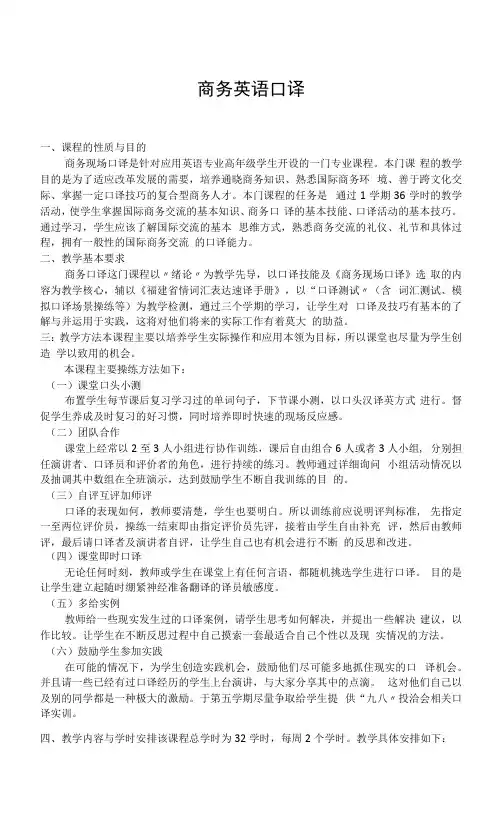
商务英语口译一、课程的性质与目的商务现场口译是针对应用英语专业高年级学生开设的一门专业课程。
本门课程的教学目的是为了适应改革发展的需要,培养通晓商务知识、熟悉国际商务环境、善于跨文化交际、掌握一定口译技巧的复合型商务人才。
本门课程的任务是通过1学期36学时的教学活动,使学生掌握国际商务交流的基本知识、商务口译的基本技能、口译活动的基本技巧。
通过学习,学生应该了解国际交流的基本思维方式,熟悉商务交流的礼仪、礼节和具体过程,拥有一般性的国际商务交流的口译能力。
二、教学基本要求商务口译这门课程以〃绪论〃为教学先导,以口译技能及《商务现场口译》选取的内容为教学核心,辅以《福建省情词汇表达速译手册》,以“口译测试〃(含词汇测试、模拟口译场景操练等)为教学检测,通过三个学期的学习,让学生对口译及技巧有基本的了解与并运用于实践,这将对他们将来的实际工作有着莫大的助益。
三:教学方法本课程主要以培养学生实际操作和应用本领为目标,所以课堂也尽量为学生创造学以致用的机会。
本课程主要操练方法如下:(一)课堂口头小测布置学生每节课后复习学习过的单词句子,下节课小测,以口头汉译英方式进行。
督促学生养成及时复习的好习惯,同时培养即时快速的现场反应感。
(二)团队合作课堂上经常以2至3人小组进行协作训练,课后自由组合6人或者3人小组, 分别担任演讲者、口译员和评价者的角色,进行持续的练习。
教师通过详细询问小组活动情况以及抽调其中数组在全班演示,达到鼓励学生不断自我训练的目的。
(三)自评互评加师评口译的表现如何,教师要清楚,学生也要明白。
所以训练前应说明评判标准, 先指定一至两位评价员,操练一结束即由指定评价员先评,接着由学生自由补充评,然后由教师评,最后请口译者及演讲者自评,让学生自己也有机会进行不断的反思和改进。
(四)课堂即时口译无论任何时刻,教师或学生在课堂上有任何言语,都随机挑选学生进行口译。
目的是让学生建立起随时绷紧神经准备翻译的译员敏感度。


说课材料【课程说明】本课程为商务英语专业的听说课程,是学生学习商务英语技能的基础应用性课程。
本课程实践性很强,本课程以实际工作任务为引领,以商务英语听说作为学生的基本技能,根据学生的认知特点,采用交际法来展示教学内容,通过创设情景、仿真模拟、小组工作、项目活动来组织教学,倡导学生在“做中学”,以“实用、够用、能学”为原则,培养学生初步具备运用商务英语的基础职业能力。
本课程的教学目的在于培养和提高学生的日常英语交流能力,为今后的学习和工作打好基础。
教师需要科学的对课堂教学进行设计和指导,教学重点不放在语法上,而是注重语言交际过程,将交流的有效性作为听说训练的首要目标。
教师应多给学生提供练习英语听说能力的渠道和平台,注重基础语言技能的训练。
同时,教师应有意识地将课题与商务工作环境相联系,将工作任务与教学活动融为一体,创设情境,激发学生的兴趣,培养学生的职业道德素质。
【课题说明】本课为第13单元“May I take your order”的练习课。
主要目的是学习和练习有关点餐的句型与词汇。
本课题拟通过教师设置的互动情景,采用交际式、任务引领式以及分层教学法,激发学生自主学习的热情,同时注重语言基础训练,提高学生语言应用技能。
本堂课教学实施如下:1.导入设置餐厅情景,以餐厅服务员的身份熟悉菜单中的菜肴。
通过游戏的形式复习常见食物的英语表达方式,复习各类菜肴的英文表达方式,进而引出本课主题——练习如何在餐厅点餐。
2. 练习巩固从听力练习开始,进一步复习餐厅点餐的常用句型。
课上朗读听力材料的文本,并通过翻译和快速应答的练习复习基本句型。
通过模仿表演,进一步复习餐厅点餐的句型。
3. 商务情景角色扮演观看视频,思考:餐厅服务员在给客人点餐时应如何做?学生展示四个特色餐厅的菜单,其他组学生选择自己喜欢的餐厅。
设置在饭店的情景,学生分别扮演餐厅服务员和到饭店用餐的客人,以角色扮演的形式练习点餐的基本句型。
4.总结及作业布置总结各小组在角色扮演中的综合表现,学生尝试总结餐厅服务员在点餐时应如何做,最后教师进行归纳总结,并布置家庭作业:写一段话介绍你喜欢的餐厅,思考好的服务员应具备的素质。
商务英语口译教学大纲(最新)商务英语口译教学大纲商务英语口译教学大纲应由本人根据自身实际情况书写,以下仅供参考,请您根据自身实际情况撰写。
课程基本信息课程名称:商务英语口译课程时长:48学时授课学期:第2学期授课时间:周一至周四,1-2节课程目的和任务本课程的教学目标是使学生掌握商务英语口译的基本理论和技能,培养学生能够熟练地翻译并理解各种商务场合的英语口头交流,并能够流畅地用英语进行商务谈判、商业活动。
通过本课程的学习,学生应具备基本的商务英语口译能力,为将来在涉外企业、政府部门从事涉外经济贸易、翻译等工作奠定基础。
教学内容1.商务英语口译基本概念及术语(2学时)本学时将介绍商务英语口译的基本概念和术语,包括商务英语口译的定义、特点、翻译技巧等。
2.商务英语口译实践(30学时)本学时将进行商务英语口译实践,包括商务谈判、商务会议、商务参观等场景的翻译。
学生将通过模拟真实场景进行翻译练习,提高实际应用能力。
3.商务英语口译技巧(6学时)本学时将介绍商务英语口译的技巧,包括听力技巧、记忆技巧、表达技巧等。
学生将通过实践练习掌握这些技巧,提高翻译质量。
4.商务英语口译案例分析(6学时)本学时将介绍一些商务英语口译案例,学生将分析这些案例中的翻译错误和不当之处,提高实际应用能力。
5.商务英语口译测试(4学时)本学时将进行商务英语口译测试,包括听力测试、翻译测试等。
学生将通过测试检验自己的学习成果,发现自己的不足之处,及时进行改进。
教学资源本课程将使用多媒体教学、案例分析、课堂练习等多种教学资源。
同时,学生将使用教材《商务英语口译》进行教学辅助材料。
商务英语专业教学大纲商务英语专业教学大纲应由本人根据自身实际情况书写,以下仅供参考,请您根据自身实际情况撰写。
商务英语专业教学大纲:第一部分:课程基本信息商务英语专业是一门涵盖了国际贸易、市场营销、商务沟通、跨文化交际等领域的综合性学科。
本课程旨在帮助学生掌握商务英语的基本理论和实践技能,提高学生在国际商务环境中的沟通和交流能力。
《商务英语口译》教学大纲D(2)口译员在商务环境中扮演什么角色?(3) 商务环境涉及哪些专业术语?3、教学基本要求掌握商务环境的特点、常用表达方式以及口译要求和技巧,熟悉数字的口译技巧。
4、教学重点重点是商务环境的口译要求;难点是口译员在商务环境中的角色以及专业术语。
4.2教学条件多媒体教学4.3教学方法建议本课程采用情景工作任务教学方式,所编主题全部选自真实的商务交际情景,既注重口译技巧的讲解和练习,也强调商务背景知识和商务礼仪的渗透和补充;开展模拟情景口译小组练习,给学生身临口译现场的感觉,并根据口译评价指标对译员的现场表现进行同伴和师生评价,以培养学生在商务活动中自如流畅地完成口译任务的能力。
4.4考核方式及课程的成绩评定本课程的期末考试成绩占课程总成绩的70%,考试内容按教学大纲的要求进行,由各任课教师命题,各二级学院进行组题。
考试内容应紧密结合所学教材,重点考核学生的写作能力。
本课程平时成绩占课程总成绩的30%,成绩根据学生月考、完成作业的情况、在课堂上的综合表现以及参加小组活动和其他学习中心组织的活动的情况综合而定。
4.5推荐教材:商务英语口译(Business English Interpreting),对外经济贸易大学出版社。
Unit 4 Ceremonial Speed1、教学目的复习口译笔记技巧,了解商务礼仪祝词的功能、类别和结构,口译要求和技巧,译前准备,相关词汇句型,实战口译以及模拟情景口译。
2、教学内容(1)商务礼仪祝词包括哪些内容?(2)商务礼仪祝词口译的要求有哪些?(3)如何进行商务礼仪祝词口译的译前(短期和现场)准备?(4)如何应对口译困境?3、教学基本要求掌握商务礼仪祝词的口译要求、口译技巧、常用表达方式,熟悉口译笔记技巧,掌握困境应对策略。
4、教学重点重点是商务礼仪祝词的口译要求和常用表达方式;难点是口译困境应对策略。
Unit5 Business Interview1、教学目的提高学习能力、语言组织能力、反应以及能力2、教学内容复习口译记忆法,商务访谈的基本流程,联络陪同口译译前准备,相关词汇句型,陪同口译礼仪,实战口译以及模拟情景口译。
《商务英语口译》教学大纲一、课程基本信息课程编号:1512514英文名称:Business Interpreting教材:商务现场口译授课对象:英语专业本科大四学生开课学期:第七学期先修课程:口语、听力、综合英语、高级英语等课程学分/学时: 3/64教学方式:课堂讲授课程简介:商务现场口译是针对应用英语专业高年级学生开设的一门专业课程。
本门课程的教学目的是为了适应改革发展的需要,培养通晓商务知识、熟悉国际商务环境、善于跨文化交际、掌握一定口译技巧的复合型商务人才。
本门课程的任务是通过1学期64个学时的教学活动,使学生掌握国际商务交流的基本知识、商务口译的基本技能、口译活动的基本技巧。
通过学习,学生应该了解国际交流的基本思维方式,熟悉商务交流的礼仪、礼节和具体过程,拥有一般性的国际商务交流的口译能力。
二、课程教学目的和要求本课程是英语专业的一门主干方向课程,其功能在于培养既通晓商务知识,熟悉国际商务环境,善于跨文化交际,又掌握口译技巧的商务口译人才。
同时注意培养学生良好的职业道德素质、社会活动能力与应对各种商务场合的方法。
三、教学内容与学时分配Unit 1 Introduction1、教学目的旨在培养了解并基本掌握口译技巧,能较好地负担起生活接待、导游、一般性会议和简单的商务洽谈等口译任务的商务、外贸、物流、旅游、外企的技能型英语人才。
2、教学内容商务活动的外延和基本流程,商务口译的定义、内涵、特点,商务口译的原则和标准,商务口译译员的基本素养,译前准备。
(1)商务活动的基本流程?(2)商务口译的标准是什么?(3)如何做好译前准备?3、教学基本要求了解商务口译的标准和要求。
4、教学重点和难点重点是商务口译的标准和要求;难点是商务口译译员的基本素养和译前准备。
Unit 2 Business Model1、教学目的口译课主要通过训练学生的短时记忆能力、综合概括能力、记笔记能力等来综合提高学生听和口译的能力。